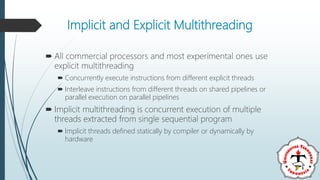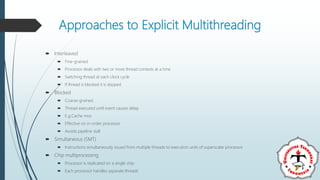Parallel Processing (Part 2)
- 1. Organisasi dan Arsitektur Komputer Ajeng Savitri Puspaningrum, M.Kom Pertemuan 31
- 3. Learning Multithreading and Multiprocessors Learning Parallelizing
- 4. Multithreading and Chip Multiprocessors Instruction stream divided into smaller streams (threads) Executed in parallel Wide variety of multithreading designs
- 5. Definitions of Threads and Processes Thread in multithreaded processors may or may not be same as software threads Process: An instance of program running on computer Resource ownership Virtual address space to hold process image Scheduling/execution Process switch Thread: dispatchable unit of work within process Includes processor context (which includes the program counter and stack pointer) and data area for stack Thread executes sequentially Interruptible: processor can turn to another thread Thread switch Switching processor between threads within same process Typically less costly than process switch
- 6. Implicit and Explicit Multithreading All commercial processors and most experimental ones use explicit multithreading Concurrently execute instructions from different explicit threads Interleave instructions from different threads on shared pipelines or parallel execution on parallel pipelines Implicit multithreading is concurrent execution of multiple threads extracted from single sequential program Implicit threads defined statically by compiler or dynamically by hardware
- 7. Approaches to Explicit Multithreading Interleaved Fine-grained Processor deals with two or more thread contexts at a time Switching thread at each clock cycle If thread is blocked it is skipped Blocked Coarse-grained Thread executed until event causes delay E.g.Cache miss Effective on in-order processor Avoids pipeline stall Simultaneous (SMT) Instructions simultaneously issued from multiple threads to execution units of superscalar processor Chip multiprocessing Processor is replicated on a single chip Each processor handles separate threads
- 8. Scalar Processor Approaches Single-threaded scalar Simple pipeline No multithreading Interleaved multithreaded scalar Easiest multithreading to implement Switch threads at each clock cycle Pipeline stages kept close to fully occupied Hardware needs to switch thread context between cycles Blocked multithreaded scalar Thread executed until latency event occurs Would stop pipeline Processor switches to another thread
- 10. Multiple Instruction Issue Processors (1) Superscalar No multithreading Interleaved multithreading superscalar: Each cycle, as many instructions as possible issued from single thread Delays due to thread switches eliminated Number of instructions issued in cycle limited by dependencies Blocked multithreaded superscalar Instructions from one thread Blocked multithreading used
- 11. Multiple Instruction Issue Diagram (1)
- 12. Multiple Instruction Issue Processors (2) Very long instruction word (VLIW) E.g. IA-64 Multiple instructions in single word Typically constructed by compiler Operations that may be executed in parallel in same word May pad with no-ops Interleaved multithreading VLIW Similar efficiencies to interleaved multithreading on superscalar architecture Blocked multithreaded VLIW Similar efficiencies to blocked multithreading on superscalar architecture
- 13. Multiple Instruction Issue Diagram (2)
- 14. Parallel, Simultaneous Execution of Multiple Threads Simultaneous multithreading Issue multiple instructions at a time One thread may fill all horizontal slots Instructions from two or more threads may be issued With enough threads, can issue maximum number of instructions on each cycle Chip multiprocessor Multiple processors Each has two-issue superscalar processor Each processor is assigned thread Can issue up to two instructions per cycle per thread
- 15. Parallel Diagram
- 16. Clusters Alternative to SMP High performance High availability Server applications A group of interconnected whole computers Working together as unified resource Illusion of being one machine Each computer called a node
- 17. Cluster Benefits Absolute scalability Incremental scalability High availability Superior price/performance
- 18. Cluster Configurations - Standby Server, No Shared Disk
- 19. Cluster Configurations - Shared Disk
- 20. Operating Systems Design Issues Failure Management High availability Fault tolerant Failover Switching applications & data from failed system to alternative within cluster Failback Restoration of applications and data to original system After problem is fixed Load balancing Incremental scalability Automatically include new computers in scheduling Middleware needs to recognise that processes may switch between machines
- 21. Parallelizing Single application executing in parallel on a number of machines in cluster Complier Determines at compile time which parts can be executed in parallel Split off for different computers Application Application written from scratch to be parallel Message passing to move data between nodes Hard to program Best end result Parametric computing If a problem is repeated execution of algorithm on different sets of data e.g. simulation using different scenarios Needs effective tools to organize and run
- 22. Cluster Middleware Unified image to user Single system image Single point of entry Single file hierarchy Single control point Single virtual networking Single memory space Single job management system Single user interface Single I/O space Single process space Checkpointing Process migration
- 23. Blade Servers Common implementation of cluster Server houses multiple server modules (blades) in single chassis Save space Improve system management Chassis provides power supply Each blade has processor, memory, disk
- 24. Cluster vs SMP Both provide multiprocessor support to high demand applications. Both available commercially SMP for longer SMP: Easier to manage and control Closer to single processor systems Scheduling is main difference Less physical space Lower power consumption Clustering: Superior incremental & absolute scalability Superior availability Redundancy
- 25. Nonuniform Memory Access (NUMA) Alternative to SMP & clustering Uniform memory access All processors have access to all parts of memory Using load & store Access time to all regions of memory is the same Access time to memory for different processors same As used by SMP Nonuniform memory access All processors have access to all parts of memory Using load & store Access time of processor differs depending on region of memory Different processors access different regions of memory at different speeds Cache coherent NUMA Cache coherence is maintained among the caches of the various processors Significantly different from SMP and clusters
- 27. CC-NUMA Operation Each processor has own L1 and L2 cache Each node has own main memory Nodes connected by some networking facility Each processor sees single addressable memory space Memory request order: L1 cache (local to processor) L2 cache (local to processor) Main memory (local to node) Remote memory Delivered to requesting (local to processor) cache Automatic and transparent
- 28. Memory Access Sequence Each node maintains directory of location of portions of memory and cache status e.g. node 2 processor 3 (P2-3) requests location 798 which is in memory of node 1 P2-3 issues read request on snoopy bus of node 2 Directory on node 2 recognises location is on node 1 Node 2 directory requests node 1’s directory Node 1 directory requests contents of 798 Node 1 memory puts data on (node 1 local) bus Node 1 directory gets data from (node 1 local) bus Data transferred to node 2’s directory Node 2 directory puts data on (node 2 local) bus Data picked up, put in P2-3’s cache and delivered to processor
- 29. Cache Coherence Node 1 directory keeps note that node 2 has copy of data If data modified in cache, this is broadcast to other nodes Local directories monitor and purge local cache if necessary Local directory monitors changes to local data in remote caches and marks memory invalid until writeback Local directory forces writeback if memory location requested by another processor
- 30. NUMA Pros & Cons Effective performance at higher levels of parallelism than SMP No major software changes Performance can breakdown if too much access to remote memory Can be avoided by: L1 & L2 cache design reducing all memory access Need good temporal locality of software Good spatial locality of software Virtual memory management moving pages to nodes that are using them most Not transparent Page allocation, process allocation and load balancing changes needed Availability?
- 31. Processor Designs Pipelined ALU Within operations Across operations Parallel ALUs Parallel processors
- 32. Chaining Cray Supercomputers Vector operation may start as soon as first element of operand vector available and functional unit is free Result from one functional unit is fed immediately into another If vector registers used, intermediate results do not have to be stored in memory
- 34. Refference Stalling, William, Computer Organization and Architecture, 10th Edition, Pearson, 2015 Abdurohman, Maman, Organisasi dan Arsitektur Komputer revisi ke-4, Penerbit Informatika, 2017



































